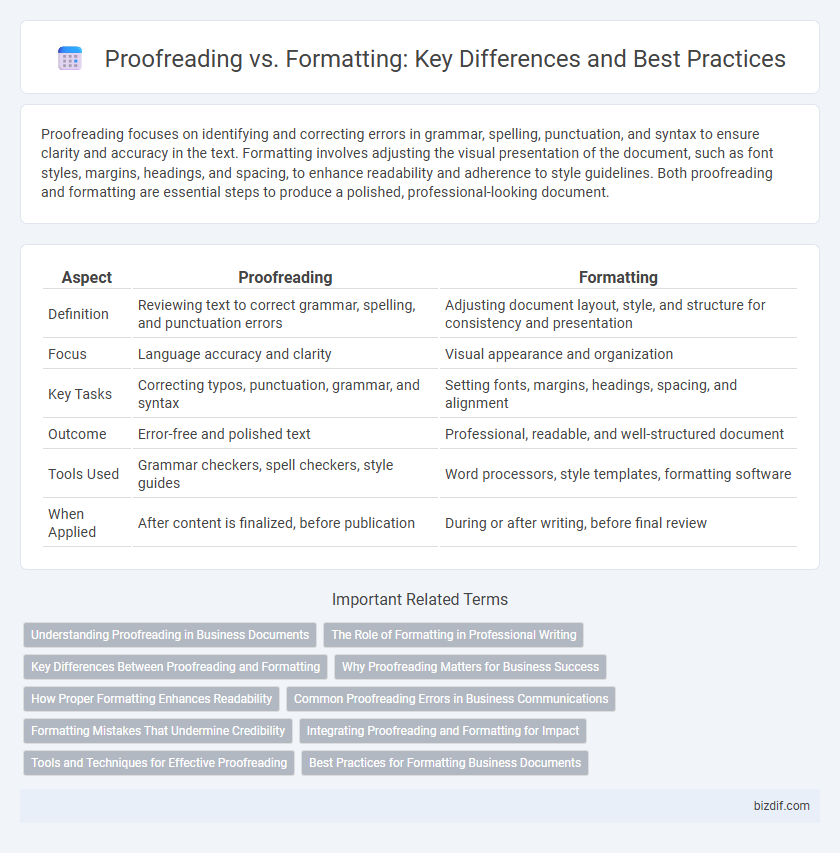Proofreading focuses on identifying and correcting errors in grammar, spelling, punctuation, and syntax to ensure clarity and accuracy in the text. Formatting involves adjusting the visual presentation of the document, such as font styles, margins, headings, and spacing, to enhance readability and adherence to style guidelines. Both proofreading and formatting are essential steps to produce a polished, professional-looking document.
Table of Comparison
| Aspect | Proofreading | Formatting |
|---|---|---|
| Definition | Reviewing text to correct grammar, spelling, and punctuation errors | Adjusting document layout, style, and structure for consistency and presentation |
| Focus | Language accuracy and clarity | Visual appearance and organization |
| Key Tasks | Correcting typos, punctuation, grammar, and syntax | Setting fonts, margins, headings, spacing, and alignment |
| Outcome | Error-free and polished text | Professional, readable, and well-structured document |
| Tools Used | Grammar checkers, spell checkers, style guides | Word processors, style templates, formatting software |
| When Applied | After content is finalized, before publication | During or after writing, before final review |
Understanding Proofreading in Business Documents
Proofreading in business documents involves meticulously reviewing text to identify and correct grammatical errors, spelling mistakes, and punctuation issues to ensure clarity and professionalism. This process differs from formatting, which focuses on the layout, font styles, spacing, and overall visual presentation of the document. Effective proofreading enhances communication accuracy and reinforces the credibility of business correspondence.
The Role of Formatting in Professional Writing
Formatting in professional writing ensures clarity, consistency, and visual appeal, enhancing reader comprehension and engagement. Proper use of headings, fonts, spacing, and alignment organizes content logically, supporting the document's purpose and audience. While proofreading focuses on correcting grammar and typos, formatting shapes the overall presentation, making the text accessible and professional.
Key Differences Between Proofreading and Formatting
Proofreading involves meticulously checking text for grammatical, spelling, punctuation, and typographical errors to ensure clarity and accuracy. Formatting focuses on the visual presentation and structure of a document, including font styles, headings, margins, and spacing to enhance readability and comply with style guides. The key difference lies in proofreading's emphasis on language correctness versus formatting's role in document layout and design consistency.
Why Proofreading Matters for Business Success
Proofreading ensures error-free content that enhances professional credibility and builds customer trust, which are critical for business success. Accurate text prevents misunderstandings and maintains a polished brand image, increasing audience engagement and conversion rates. Unlike formatting, which focuses on the presentation, proofreading refines the substance, directly impacting communication effectiveness and corporate reputation.
How Proper Formatting Enhances Readability
Proper formatting structures a document by organizing text, headings, and spacing, which significantly enhances readability and user experience. Consistent font styles, margins, and alignment prevent visual clutter, making it easier for readers to absorb information quickly. While proofreading corrects grammar and spelling errors, effective formatting ensures that the content is visually accessible and engaging.
Common Proofreading Errors in Business Communications
Common proofreading errors in business communications include overlooked typos, inconsistent punctuation, and incorrect verb tenses that can undermine professionalism. Misplaced commas and homophone confusion, such as "their" versus "there," often lead to misunderstandings and reduced clarity. Proper proofreading ensures accuracy, clear messaging, and maintains the company's credibility by eliminating these typical mistakes.
Formatting Mistakes That Undermine Credibility
Formatting mistakes such as inconsistent font styles, irregular spacing, and misaligned margins significantly undermine a document's credibility by distracting readers and suggesting carelessness. Proper formatting ensures clarity and professionalism, reinforcing the trustworthiness of the content. Neglecting formatting details can lead to misinterpretation and reduce the overall impact of the written work.
Integrating Proofreading and Formatting for Impact
Integrating proofreading and formatting enhances the clarity and professionalism of any document by ensuring both textual accuracy and consistent presentation. Combining error correction with standardized styles improves readability while reinforcing the author's intended message. This holistic approach maximizes the document's impact, making content visually appealing and linguistically precise.
Tools and Techniques for Effective Proofreading
Effective proofreading relies on specialized tools such as grammar checkers, spell checkers, and style guides that identify language errors and inconsistencies. Techniques like reading aloud, using printed copies, and reviewing text in multiple passes enhance error detection beyond automated tools. Combining digital resources with manual strategies ensures comprehensive error correction and improved text quality.
Best Practices for Formatting Business Documents
Effective formatting of business documents enhances readability and professionalism by using consistent fonts, appropriate headings, and clear paragraph structures. Employing standardized margins, line spacing, and bullet points ensures organized content presentation that supports the document's purpose. Proofreading complements formatting by eliminating errors and improving overall clarity, but focusing on style guides like APA or MLA guarantees uniformity across business communications.
Proofreading vs Formatting Infographic

 bizdif.com
bizdif.com